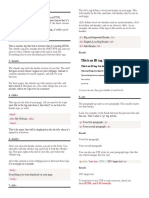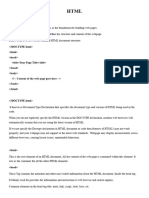0% found this document useful (0 votes)
5 views1 pageHTML Tags
The document provides a list of essential HTML tags along with their explanations. It covers tags such as <!DOCTYPE html>, <html>, <head>, <body>, and various others used for structuring and formatting web pages. Each tag is briefly described to highlight its purpose and usage in HTML documents.
Uploaded by
ajaya.beheraCopyright
© © All Rights Reserved
We take content rights seriously. If you suspect this is your content, claim it here.
Available Formats
Download as PDF, TXT or read online on Scribd
0% found this document useful (0 votes)
5 views1 pageHTML Tags
The document provides a list of essential HTML tags along with their explanations. It covers tags such as <!DOCTYPE html>, <html>, <head>, <body>, and various others used for structuring and formatting web pages. Each tag is briefly described to highlight its purpose and usage in HTML documents.
Uploaded by
ajaya.beheraCopyright
© © All Rights Reserved
We take content rights seriously. If you suspect this is your content, claim it here.
Available Formats
Download as PDF, TXT or read online on Scribd
/ 1



























































